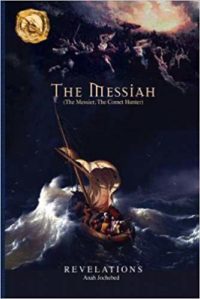Title: The Messiah (the Messier, the Comet Hunter)
Author: Anah Jochebed
Publisher: Toplink Publishing, LLC
ISBN: 978-1949502831
Pages: 278
Genre: Religious History
Reviewed by: Carl Conrad
Hollywood Book Review
The Messiah, by Anah Jochebed, is a book that is deep and rich in religious mythology, although that may be because it is not one book by one author, but a collection of parts of many books by many profound authors with predictably profound insights into the origins and resulting outcomes of humankind’s destiny. In fact, because of the seemingly disjointed arrangement and unclear identification of these writings, it is difficult to tell which, if any of these, are Ms. Jochebed’s original writings and whether any of the others have been used by permission or just as perhaps conscriptions of public domain?
At a cursory glance, the book appears to be a collection of stories which tell of humankind’s mythical and religious evolution and persecution. Yet, as one digs deeper into the meaning and relevance of the many references in the book – to alchemy, Hermeticism, Gnosticism, Orphism, Enochians, and many other themes which lead in near-infinite directions – not only are many answers given, but huge amounts of history and interrelated myths are also revealed behind them.
There is an incredible range of material in the book from ancient writings, to poetry and narratives, to religious scriptures, to even some biographical information given about the author’s time in the military (Army Reserves) and hospitalization (mental institution). Plus there are many breathtaking reproductions of historic paintings that capture the essence and messages of the text.
Such impressive painters as Ludolf Backhuysen, Gustave Doré, Vasili Surikov, John Collier Allart, El Greco, and Fra Angelico meticulously merge myth with reality to show images that would otherwise have been beyond comprehension, and paintings like “Christ in The Storm on The Sea of Galilee”, “Nailing of Christ to the Cross”, “The Nativity”, “The Harrowing of Hell”, “The Expulsion from Paradise”, and “Moses and the Exodus” show exquisite artist’s renderings of these events. Dante’s Inferno (Hell), The Garden of Gethsemane (Crucifixion), The Dark Forest (Adam and Eve), and Apocalypsis Mosis (Cain and Abel), as well as The Book of Thomas (Dead Sea Scrolls) all contribute to the myths that unfold as you read through the book.
Cryptically, the book is entitled The Messiah, (The Messier, The Comet Hunter) in which, like the French astronomer, Charles Messier who identified 103 comets in the 1700’s which were said to be disorderly and disorganized, perhaps this book has collected a collection of paintings, writings, and myths to show a way out of chaos and into the light.
The Messiah is not for the light reader, but, if you want to understand how religious history and mythology, painters, or philosophers have understood God across eras of society, this is a good resource. Plan to read a chapter, or section of a chapter, at a time, then set it down to contemplate. I recommend this book for anyone whether a person of faith or not to understand how we got to where we are today with the various faiths of our world.

